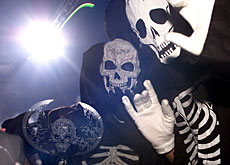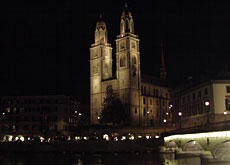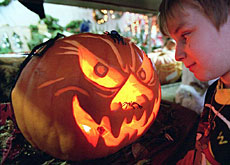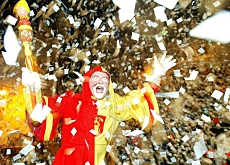Halloween retailers get a shock

After a short but sweet dabble with Halloween, Switzerland has started to lose interest in the originally Pagan custom.
This year Migros and Coop, the country’s largest retailers, are hardly stocking any Halloween-related goodies and even specialist suppliers are feeling the pinch.
“Demand is much lower now than it was four or five years ago,” a spokesman for Ballon-Müller, which sells Halloween paraphernalia wholesale, told swissinfo.
“We had a peak then and it’s possible that people have had enough of Halloween.”
The spokesman said demand for Halloween products had fallen sharply in the past two to three years.
Theories for the rise and subsequent fall of Halloween in Switzerland range from the obvious – problems identifying with an imported and increasingly commercialised custom – to the less obvious – does the fact that many Swiss live in flats make trick or treating less lucrative and worthwhile?
It has also been speculated that Halloween is a victim of geopolitical fallout: “[The decline] might also have something to do with the fact that Halloween comes from the United States, which does not have such a good image right now,” said the spokesman from Ballon-Müller.
Ueli Mäder, a professor of sociology at Basel University, told swissinfo that the Swiss adoption of Halloween about ten years ago – Swiss shops stocked Halloween costumes and masks for the first time in 1999 – came from “a need for rituals”.
“In a strongly commercialised world a need arises for meaningful experiences. I can imagine that a ritual like Halloween when it is celebrated in a simple genuine way can satisfy that need.”
But he added: “It also took on an exaggerated or extreme form for a while which probably turned some people off. Perhaps is there is a need to bring Halloween back to a more simple level.”
Costume fatigue
There could also be an element of costume fatigue creeping in. The Swiss already rarely miss a chance to slip into something more traditional.
Barely a month after Halloween, on December 6, is St Nicholas Day – a warm-up for Christmas – which also has similarities with Halloween in that children are given rewards, such as tangerines, nuts, gingerbread and other treats.
But the main carnival season in Switzerland is in February, in the run-up to Lent, when costumed and masked revellers come out in force and process through the streets to the sounds of brass bands.
The authorities in many Swiss towns tried to ban the wearing of costumes, and on at least three occasions carnival led to open rebellion.
Marketing exercise
But Mäder disagrees that Switzerland has enough traditions and doesn’t feel the need to import new ones.
“We don’t have such a distinct culture of rituals that are intensively practised,” he said, adding that for him Halloween is not so much connected to language regions than religion.
“In more Catholic areas Halloween is celebrated more, possibly because of the emphasis on rituals in Catholic tradition.”
But he acknowledges the commercial aspect to Halloween.
“Halloween, like other rituals and traditions, presents opportunities for people to make money. However I don’t believe it’s a pure marketing phenomenon. Yes, marketing plays a role, but there are also many people who are resistant to strong marketing and find it over the top.”
Not all gloom and doom
The humble pumpkin, on the other hand, continues to go from strength to strength. Once traditionally eaten by paupers, pumpkins now find themselves on many haute cuisine menus – thanks in a large part to Halloween.
In 1985, 2.2 tonnes of pumpkin – botanically classed as a fruit – were harvested in Switzerland, according to the Swiss Vegetable Producers Association. In recent years however this figure has rocketed to more than 1,000 tonnes.
swissinfo
The name Halloween dates back to the 16th century and comes from “All Hallows Eve” on October 31, the day before All Saints Day.
To protect themselves against malevolent spirits, Celts burned fires outside their homes. Today lanterns made from hollowed-out pumpkins have replaced the fires.
Introduced to the United States by Irish immigrants in the 18th century, Halloween was modified by Americans over the years and is now firmly ensconced in US culture.
Halloween then returned across the Atlantic in the 1980s, boosted in 1982 by the globally successful film E.T., which took place during Halloween.
Today’s American-style celebrations, such as trick or treat or lighting pumpkins, are relatively new to Switzerland, but the country has its own ghostly traditions linked to this time of year.
One of these also involves lighting pumpkin lanterns to protect people against malevolent spirits.

In compliance with the JTI standards
More: SWI swissinfo.ch certified by the Journalism Trust Initiative



You can find an overview of ongoing debates with our journalists here . Please join us!
If you want to start a conversation about a topic raised in this article or want to report factual errors, email us at english@swissinfo.ch.